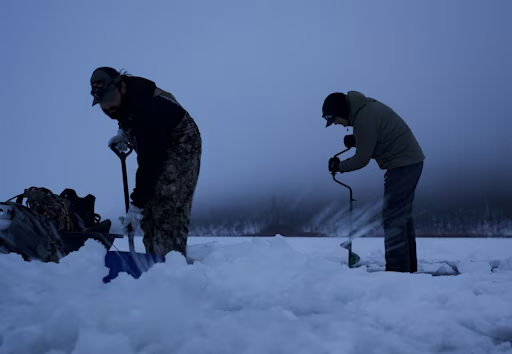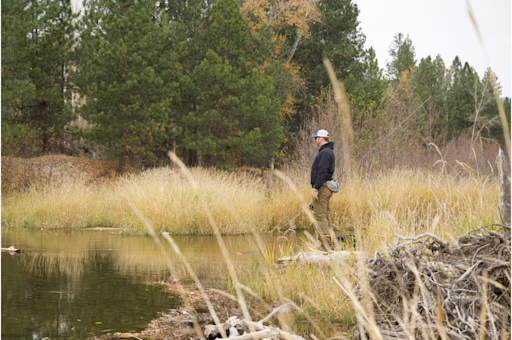Fall is for pike
Learn about fall's effect on pike behavior and how you can take advantage.
Share this article

A morning chill has you zipping up your jacket and orange leaves rattle on trees. Your first cast is at a weed bed, hidden behind a layer of fog on the lake’s surface. Flocks of geese and ducks are silhouetted against the sky with their honks and quacks providing the soundtrack of a perfect fall morning.
Your next cast is perfect, right at the edge of the weeds. Two cranks on the reel are interrupted by that oh so familiar tug on your line, a violent crash of water and equally violent headshakes.
After several more splashing jumps and strong runs, you get the fish into your net, careful to avoid the rows of sharp teeth. You hold up the thick, snake-like body, admiring the patterns across the body and tail of the fish through a break in the clouds.
Pike fishing can be great year round, but the almost universal favorite time to catch a large water wolf is fall. Changing weather, habitat and baitfish patterns can stack fish in limited habitat and the impending winter can have fish voraciously hungry.
Below is some of our best advice for targeting our favorite toothy, freshwater predator, just in time to truly enjoy everything fall has to offer.

Find the disappearing weeds.
In most lakes and pike rivers, weed beds are plentiful late spring through summer. Pike gravitate toward these beds as the weeds supply oxygen, which attracts insects, baitfish and ultimately pike.
When fall weather leads to dropping temperatures, these havens for pike and baitfish begin turning brown and dying off. Not all weed beds die off at the same time, however. As weeds die off, insects and baitfish will congregate toward the last remaining weed beds still providing cover and oxygen. Pike will naturally follow their prey.
This will, thankfully, consolidate pike into the remaining few weedbeds, concentrating them.
Weeds can be so full of pike, anglers should start by targeting the outside edges. Your casts will attract fish on the perimeter, not spooking the rest of the pike haven.
As temperatures turn even colder, the warmer water will be deeper, meaning you may need to locate green weeds with depth finders when you can't see them from the shore, or a boat.
Water temperature will still dictate where you fish in the water column. Baitfish may still be up toward the surface, or far below, depending on where the warmest water is.

Baitfish on the move
Find the prey and you’ll find the predator and beside targeting weeds, shallow waters are most likely to hold pike this time of year. Fall is spawn time for tullibees, which make up a large part of a pike’s diet in the fall. Tullibees spawn in shallow water, similar to walleye, and if your timing is right, that is where you should be looking for hungry pike and if you’re really lucky a big muskie.
The location of the shallower waters makes for great fishing accessibility for both boat anglers and shore anglers alike.

Watch the wind
Wind in fall is an inevitability and it can and should dictate how and where you fish. A small amount of chop on the water often increases pike activity. Some studies have shown a direct correlation between rising pike activity and the diminished light coming through the water. Overcast days are also more desirable to fish for the same reasons.
Other theories as to why some wind is beneficial is because the choppy service moves water, creating more oxygen, specifically for baitfish, which raises activity levels.
Wind direction is imperative in planning your day. Wind pushes water into banks, coves, structure and more, creating a current that also pushes bait.
Pike will naturally seek cover behind structure blocking the wind powered current, much like a trout in a river will, to conserve energy and use the current as a food conveyor belt.

Temperature dictates presentation
The first temperature drop of the year should signal anglers as much as it signals big pike. That first taste of fall for us is like a beacon to get on the water and throw big baits, because for pike, that first cool morning means it's time to feed.
A consistent drop in temperature is like a reminder for predatory fish that winter is on the way and it's time to eat.
Cast retrieves should be quick, taking advantage of the increased feeding activity and triggering the already high predatory response. High 50s to 60s are the ideal water temperatures for this.
Pike metabolism slows down, however, when the water starts dipping in the lower 50s realm and below. These temperatures start making pike more sluggish and less willing to chase as hard. Presentation and retrieval in these conditions needs to slow as you try to make the presentation both enticing enough to follow, but slow enough for a sluggish pike to grab. Anglers must consider that when water is this cold feeding becomes a means of gaining calories while conserving as many as possible for the fish.
Fishing doesn’t end with summer, in fact many would argue it only gets better. Plus there’s no such thing as bad weather, only soft anglers. Throw on your jacket, pull on your gloves and pick out your favorite, big baits. Big pike are biting and just waiting for your next cast.
Now let’s go fishing. We’ll bring the big lures.
If you haven't experienced the #1 fishing app worldwide, make sure and check out Fishbrain to see all the fish data, fishing spots, weather conditions you've been missing out on plus much more.

Download the Fishbrain app and access the best fishing spots in your area
Related blog posts
Master the hardwater season with advanced ice fishing tips . Learn how to find fish faster, refine your search and adjust presentations to catch more fish all winter long.

Your guide to Victoria’s best fish to catch in rivers, lakes, and coastal waters. Learn prime species, fishing tips, and key regulations

Learn how fish adapt as water temperatures cool from autumn to winter, including changes in behavior, metabolism, and habitat that help them survive.




